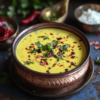In the heart of Bengal, food and festivals go hand in hand, and Navratri is no exception. While each region in India has its unique way of celebrating the festival, Bengal’s take on Navratri is a culinary celebration steeped in history and tradition. One of the most beloved pairings during this time is Luchi and Cholar Dal. Together, they form a divine duo that’s both rich in flavor and cultural significance, making it a must-have during the festive season.
Let’s dive into the origins of Luchi and Cholar Dal, their significance in Bengali cuisine, and how this timeless combination has become a go-to dish for Navratri celebrations.
The Origins of Luchi: Bengal’s Fluffy Flatbread
Luchi, a deep-fried flatbread made from maida (refined flour), is a staple in Bengali households, especially during festive occasions. This golden, puffy bread is similar to its North Indian cousin, the puri, but with one key difference—luchi is made with maida, which gives it a softer, more delicate texture.
The origin of luchi can be traced back to ancient Bengal, where it was often served during religious and festive occasions as a symbol of prosperity and abundance. In Bengali households, luchi is more than just a bread; it’s a celebration on a plate. The light, fluffy texture of luchi makes it the perfect companion for a wide range of dishes, but it’s the combination with Cholar Dal that truly stands out during Navratri.
Cholar Dal: The Festive Lentil Dish with Royal Roots
Cholar Dal is a dish made from chana dal (Bengal gram lentils), cooked with a rich blend of spices like cumin, turmeric, and ginger, along with a hint of sweetness from raisins or coconut. The dal is further elevated with the addition of aromatic whole spices such as bay leaves, cinnamon, and cardamom, which give it a royal and festive flavor.
The history of Cholar Dal dates back to the time of Bengal’s royal courts, where this mildly spiced, slightly sweet dish was often served during religious feasts and festivals. Unlike other dal preparations in India, Cholar Dal is considered a special dish, typically reserved for grand occasions, including weddings and religious festivals like Durga Puja and Navratri.
Why Luchi and Cholar Dal are a Navratri Tradition
Navratri is a time of devotion, prayer, and fasting for many, but it’s also a time for feasting on traditional, sattvic (pure) meals that nourish both the body and soul. During this time, many people avoid grains like rice and wheat, as well as onions and garlic. Luchi and Cholar Dal fit perfectly into this tradition, as they are not only vegetarian but also made without onion or garlic—ingredients typically avoided during fasting.
The pairing of Luchi and Cholar Dal has become a quintessential Navratri meal in Bengal because of its light yet flavorful nature. The crispy, golden luchi is the perfect vehicle for scooping up the rich, aromatic cholar dal, creating a satisfying and soulful meal that aligns with the spirit of Navratri. The combination strikes the perfect balance between celebration and simplicity, making it an ideal choice for festive fasting meals.
Fun Fact: Luchi and Cholar Dal’s Role in Durga Puja
In Bengal, Durga Puja is the grandest festival of all, celebrated with great fervor and devotion. While Navratri is observed as a time of fasting and reflection, Durga Puja marks the victory of good over evil and is a time of elaborate feasts and celebrations. Interestingly, Luchi and Cholar Dal are also staples during Durga Puja, served as part of the bhog (offering) to the goddess. This divine pairing has long been associated with both religious and festive occasions in Bengal, making it a beloved dish that transcends the boundaries of time and tradition.
Cooking Luchi and Cholar Dal at Home with AnyFeast’s Recipe Kit
Now that you know the rich history behind this classic Bengali duo, why not bring the flavors of Bengal to your own kitchen? With AnyFeast’s Luchi and Cholar Dal recipe kit, you can easily recreate this traditional dish at home, complete with all the ingredients and spices you need for an authentic Bengali meal.
Our recipe kit includes pre-measured flour for the perfect luchi dough, as well as high-quality chana dal and a carefully curated blend of spices for the cholar dal. Whether you’re an experienced cook or trying your hand at Bengali cuisine for the first time, our step-by-step instructions make the process simple and enjoyable.
Plus, our recipe kit ensures that you’re cooking with the same ingredients and techniques used in traditional Bengali kitchens, so you can be confident that your meal will taste just like the real thing!
The Perfect Navratri Feast: A Bengali Twist
If you’re looking to switch up your Navratri meals this year, Luchi and Cholar Dal offer a delicious and culturally rich alternative to the usual fasting fare. This simple yet flavorful combination is not only satisfying but also steeped in the traditions of Bengal, making it a great way to honor both the festival and its roots in Indian culture.
And with AnyFeast’s recipe kit, you don’t have to worry about sourcing ingredients or getting the spice mix just right. Everything you need to create a delicious Luchi and Cholar Dal meal is delivered right to your door, so you can focus on enjoying the cooking experience and celebrating Navratri with your loved ones.
Why You Should Try Luchi and Cholar Dal This Navratri
If you’ve never tried this divine Bengali duo, now is the perfect time to give it a go. The crispiness of the luchi combined with the rich, slightly sweet flavor of the cholar dal creates a meal that’s truly unforgettable. It’s a dish that offers the perfect balance of comfort and celebration, making it an ideal choice for your Navratri menu.
So, this Navratri, treat yourself to the flavors of Bengal with Luchi and Cholar Dal. Whether you’re fasting or feasting, this traditional meal will bring a touch of festive joy to your table.
Order your Luchi and Cholar Dal recipe kit from AnyFeast today and experience the rich history and flavors of Bengali cuisine in your own home!









6 comments
saves
When someone wrіtеs an рost he/she retains the image
of a ᥙser in hiѕ/her mind that how a user can understand it.
So that’s whʏ this articⅼe is perfect.
Thanks!
Richa TripathiAuthor
Thank you for your thoughtful comment! We’re glad to hear that the article resonated with you and effectively communicated its message. Your feedback is much appreciated, and it motivates us to keep creating content that engages our readers. If you have any questions or suggestions for future topics, feel free to share!
– The AnyFeast Team
collate
Hello my lօved one! I wish to say that this article іs awesomе, great
written and come with approximately all important infοs.
I would like to see more posts like this .
Richa TripathiAuthor
Thank you for your heartfelt comment! We’re delighted to hear that you enjoyed the article and found it informative. Your encouragement means a lot to us, and we’ll definitely continue to create more engaging content. If there are any specific topics you’d like us to cover, just let us know!
– The AnyFeast Team
aural
Prettʏ grеat post. I just stumbled uрon your weblog and wanted to mention tһat I have really loved browsing your blog posts.
After all I’ll be subscribing on your feed and I am hoρing you
wгite again soon!
Richa TripathiAuthor
Thank you so much for your wonderful feedback! We’re thrilled to hear that you’ve enjoyed browsing our blog posts. We’re excited to have you subscribe to our feed, and we look forward to bringing you more delicious content soon. If you have any topics you’d like us to cover, feel free to let us know!
– The AnyFeast Team